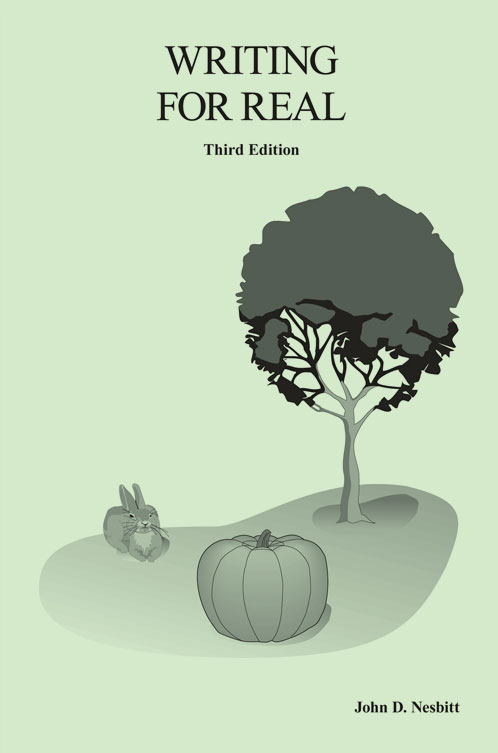
Writing for Real is a textbook I have composed for my classes in college composition. It first began to take shape many years ago, when I was putting together a manual for a distance course in composition. At that time, I wrote up quite a bit of material that I used to present in lecture or discussion, and I plundered material that I had included in an earlier version of the Blue Book of Basic Writing (ostensibly for a broader audience, at the suggestion of the publisher at the time) but did not use to any appreciable extent and then took out.
All of this I combined with handouts and assignments I had developed. Once I got the content combined and smoothed out, I had a workable manual for students to follow as they worked through the exercises and essay assignments in the distance course. For the next step, I used the manual in an on-campus course, and I saw that it worked well in helping me present the course content in an efficient manner. With a little more work I had it into book form, and the good people at Endeavor Books have been great to work with in making inexpensive copies available to my students.
For content, this book has traditional chapter topics. It begins with a chapter of introduction to college composition, which includes not only general ideas about writing college essays but also suggestions about outlining and vocabulary work. Subsequent chapters cover summary and paraphrase, definition, classification, narration, description, process analysis, argumentation, and comparison and contrast. In each of these chapters, there is coverage of the topic as a skill or method (as in service of an essay with a larger purpose) and then coverage of how to write an essay of that nature. Following these chapters is a short one on revision and correction.
Within each chapter, in addition to discussions of method and organization, I have included reading selections and sample essays. The reading selections are taken from works no longer under copyright, such as Benjamin Franklin’s Autobiography or Thoreau’s Walden. The sample essays are mostly pieces of my own composing, many of them written over the years in response to my own assignments. My one regret in using this book is that it has taken over the role of the various rhetoric/anthology texts I used to use in addition to a handbook. (I still assign and use a handbook.) When I used to use an anthology, I had a greater range of authors, styles, and voices, even though many of those selections were not models for the kinds of essays the students write in a first-year college composition course. During the time that my modest text has supplanted selections that operate on a higher level, however, our semester has been shortened and the general level of students’ academic preparation has gone down, so I do not know that some of the anthologies I used to use would see as much use now.
Meanwhile, as is mentioned in the Preface, I have tried to incorporate some worthwhile content on use of the English language at the same time that I have tried to promote cultural literacy and appreciation for the environment. I have also tried to make the book reflect the practical world, in which real people do real work (including learning and writing as well as harvesting crops, cutting up chickens, and saddling horses) and in which real products (such as bacon, eggs, and tortillas as well as shoes and books) come from real sources. Thus the reader will come across sample essays on using metaphors and planting trees, interspersed with essays of historical and cultural interest. In this respect, the book is a kind of sequel to the Blue Book of Basic Writing. If the Blue Book is the only extant book in which an essay about Queen Victoria appears back-to-back with an essay on Pancho Villa (and I think it is), Writing for Real may be the only book in which an essay about the term “Victorian” is followed by an essay about signature killers and the Black Dahlia murder. Charles Dickens and his novel Great Expectations come in for reference and excerpt as well, as do Samuel Johnson, Washington Irving, Harriet Beecher Stowe, Herman Melville, and Mary Austin.
Although this is a small-scale product with its inherent limitations, it has been a useful book for me to work with, and my intentions at least have not been trivial. I do hope that in the future, some students will be better equipped to write an essay of a given nature, and I do hope that some of them will have a better idea of what a Victorian mansion is. As for Irving, Dickens, and Melville, of course I hope to make their names familiar, and I am happy to say that they are in the sequel as well.
Writing for Real will become available on Amazon again soon.


Leave a Reply
You must be logged in to post a comment.